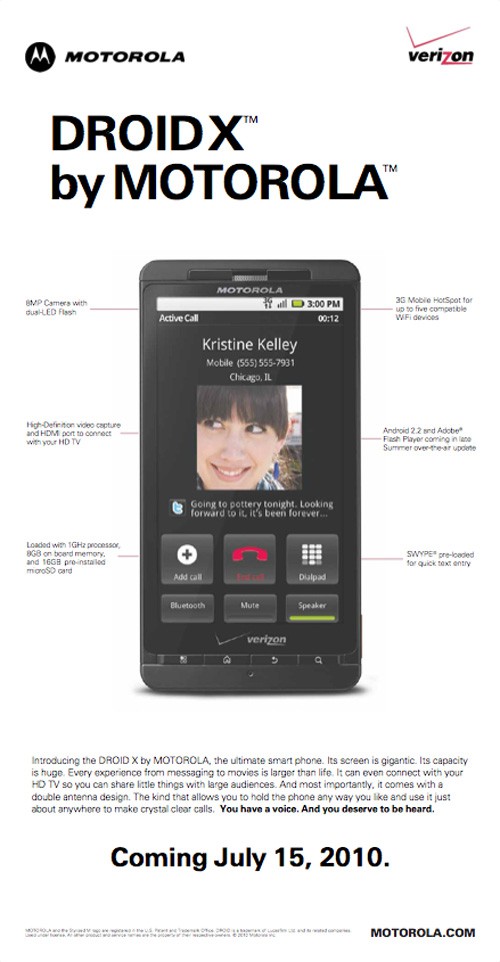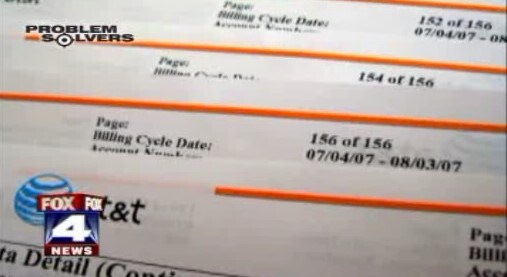
A full page ad from Verizon mocks Apple's iPhone reception problems (click to enlarge)
Apple wants customers to believe it’s not a head-slapping design flaw that is bringing iPhone reception to its knees when holding the phone, it’s the software that is telling you AT&T’s reception quality is better than it really is. Change the formula to calculate how many bars of signal strength AT&T is not delivering to its customers, problem solved.
But just how will Apple make its fan base believe those dropped calls and lousy data transmission rates, made worse when holding the phone “the wrong way” are just the result of some software bug?
In a statement released Friday, Apple told worried customers the latest version of the phone remained the best it had ever produced, and the lack of signal shown on the display is a software problem (inferring AT&T’s usual network issues), not a fundamental design flaw:
Upon investigation, we were stunned to find that the formula we use to calculate how many bars of signal strength to display is totally wrong. Our formula, in many instances, mistakenly displays 2 more bars than it should for a given signal strength. For example, we sometimes display 4 bars when we should be displaying as few as 2 bars. Users observing a drop of several bars when they grip their iPhone in a certain way are most likely in an area with very weak signal strength, but they don’t know it because we are erroneously displaying 4 or 5 bars. Their big drop in bars is because their high bars were never real in the first place.
To fix this, we are adopting AT&T’s recently recommended formula for calculating how many bars to display for a given signal strength. The real signal strength remains the same, but the iPhone’s bars will report it far more accurately, providing users a much better indication of the reception they will get in a given area. We are also making bars 1, 2 and 3 a bit taller so they will be easier to see.
We will issue a free software update within a few weeks that incorporates the corrected formula. Since this mistake has been present since the original iPhone, this software update will also be available for the iPhone 3GS and iPhone 3G.
In other words, Apple is banking that its fans are so enamored with the company and its products that just making a software change will convince customers the phone isn’t the problem. Will AT&T’s already lousy customer rating take an even bigger hit when Apple passes the buck for its design flaws to the cell phone provider?
The ongoing revelations of the flaws in the latest iteration of the Apple iPhone are stunning, if only because they were completely missed during beta testing by company employees. As we learned several weeks ago from the Apple employee who left his phone behind in a California bar, some prototype phones didn’t use the “innovative” case design now implicated in the “grip of death.” Perhaps other Bay Area testers just assumed the bouncing signal strength meter was simply AT&T-as-usual.
Now that the signal issue, among others, has been made the star of the iPhone show on YouTube, Apple has launched into damage control mode. What Apple does to regain your trust depends on what type of customer you are:
Tech-minded, Informed Consumers: Apple will have the most trouble convincing these customers to sign-on the iPhone bandwagon, especially now. Many have refused to hop on board all-along, unwilling to sacrifice their wireless phone service to AT&T. While many of these customers would happily buy an iPhone… from Verizon, news of technical defects and design faults will not inspire confidence.
Tech-minded Early-Adopters: Apple will need to fix its problems with the iPhone to keep these customers happy. They are the first to buy new products and are more forgiving of early manufacturing faults (and are among those who probably first documented and reported them), but they won’t forgive intransigence and PR nonsense. These customers want honest answers, a schedule for a solution, and mitigation — a few free iPhone case bumpers as a consolation would probably make many of these customers happy.
Non-technical Apple Devotees: If it’s from Apple, these people will buy it. They don’t have the first clue about the technical mumbo-jumbo that explains the design flawed antenna on the newest phone, and probably don’t care. They are loyal Apple customers, but they’ll happily slam AT&T for dropping their calls. Most of these customers are probably blaming any reception issues exclusively on AT&T already.
The Fanboys & Fashion-Minded: These are the folks who perennially set up the lawn chairs in front of Apple stores 15 hours before the launch of every version of the iPhone. A criticism of Apple is a personal affront, and they’ve probably already bought the company explanation for the issue. The fashion-minded treat the iPhone as a must-have personal accessory. Nothing short of a total failure of the phone will pry them loose from grabbing the latest version of the phone they need to be seen with.
For those without (or who don’t care about) iPhones, watching customers wait in long lines, proclaiming all things from Apple to be good — quickly followed by torch-bearing complaints when they are not so good brings rolling eyes and mutterings about why someone would punish themselves over a phone.
Potentially the most irritating of all is the fact Apple could make money from its design failure — by advocating consumers spend a ludicrous $30 on what is little more than a rubber band to protect the rim of the phone from your hand. Apple is selling their “bumper” case one to a package in multiple colors. For that amount of money, consumers should get one of every color. A company memo underscored the fact Apple was not about to give these out for free to aggravated customers. Why lose an opportunity to extract even more cash from devoted customers?
[flv width=”536″ height=”420″]http://www.phillipdampier.com/video/MSNBC iPhone Troubles 7-6-2010.flv[/flv]
MSNBC’s ‘Morning Joe’ was unimpressed with customers who first lauded and then “whined” about their iPhone purchases, after revelations of inherent design flaws and other quality control issues threaten to turn the product sensation into the Toyota of telephones. (3 minutes)
Class action law firms are salivating at the prospects, and attorneys claim no “software fix” is going to suddenly make the iPhone’s antenna design issues go away:
- One suit filed on behalf of Steve Tietze and others in the U.S. District Court for the Northern District of California seeks class action status. Tietze accuses Apple of unfair competition, false and misleading advertising, breach of warranty, and violation of the Consumer Legal Remedies Act.
- A second was filed in the U.S. District Court for the District of Maryland on behalf of Kevin McCaffrey, Linda Wrinn, and others accusing Apple and AT&T of knowingly distributing a phone with a malfunctioning antenna. The suit charges general negligence, defect in design, manufacture, and assembly, breach of warranty, deceptive trade practices, intentional and negligent misrepresentation, and fraud by concealment.
- Two others: Alan Benvenisty v. Apple, 10-2885, and Christopher Dydyk v. Apple, 10-2897, U.S. District Court, Northern District of California (San Francisco). “Apple’s sale of the iPhone with this unannounced defect, assuming Apple’s prior knowledge of the defect, constitutes misrepresentation and fraud,” said Christopher Dydyk of Cambridge, Massachusetts in his complaint. “In omitting to disclose the defect in the iPhone 4, Apple perpetrated a massive fraud upon hundreds of thousands of unsuspecting customers.” Dydyk wants Apple to hand out free “bumper” cases that cover the antenna in rubber to prevent signal issues.
[flv]http://www.phillipdampier.com/video/WJZ Baltimore Lawsuits Filed Over New iPhone 4 7-2-10.flv[/flv]
WJZ-TV in Baltimore covers the Maryland lawsuit seeking class action status. Baltimore area residents filed the suit against both AT&T and Apple. (1 minute)
Other phone manufacturers are laughing themselves silly at Apple’s declaration that all smartphones lose reception and drop calls based on how you hold the phone. Nokia is having a field day at Apple’s expense, promoting the fact you can hold their phones anyway you like and won’t suffer signal degradation:
One of the main things we’ve found about the 1 billion plus Nokia devices that are in use today is that when making a phone call, people generally tend to hold their phone like a…. well, like a phone. Providing a wide range of methods and grips for people to hold their phones, without interfering with the antennae, has been an essential feature of every device Nokia has built.
Of course, feel free to ignore all of the above because realistically, you’re free to hold your Nokia device any way you like. And you won’t suffer any signal loss. Cool, huh?
[flv width=”640″ height=”500″]http://www.phillipdampier.com/video/WTTG Washington iPhone Signal Strength Can Drop 7-5-10.flv[/flv]
WTTG-TV in Washington spoke with Washington Post Tech Reporter Rob Pegoraro who discussed the signal ‘death grip’ and characterized AT&T’s service quality: “we have terrible coverage and we were lying to you [about it] all along.” The report also seriously questions Apple’s claims of a “software glitch” asking why a software problem would cause calls to drop when holding the phone “the wrong way.” (4 minutes)
Apple’s public relations problem continued to grow this week when it declared earlier reports of terse e-mails purporting to be from Steve Jobs as fakes. Boy Genius Report, who compensated one recipient of the e-mails, posted e-mail headers that they represent proves the messages did, in fact, come from Apple.
Apple also was caught in a case of bad timing when blogs discovered the company posting help wanted ads seeking antenna engineers, which seemed ironic coming after the release of the much-anticipated iPhone 4.
One biochemist offered his advice for free:
Subject: HowToFix for minimal cost — hydrophobic organic thin film layer
Hi,
In truth, Apple’s explanation for iPhone 4 signal reception problem is inaccurate at best and disingenuous at worst. iPhone users are in some of the hottest and most humid parts of the country this summer and have salty, damp hands especially at events such as baseball games, barbecues, or other outdoor activities. having bare metal antennae purposely handled will absolutely short the signal. This problem will be difficult to reproduce in Apple’s labs because the engineers are required to wash their hands before touching devices, which also strips off the natural hand electrolytes that are ever-present in the field on a hot day.
Anyway, the solution is not a redesign of the phone, but rather an electrically insulating organic hydrophobic layer atop the bare metal. a variety of plastics will work, such as polyethers, polystyrenes, or nylons. you could even use the plastic labels ever-present on aluminum soda cans, which likewise have an electrically insulating effect when holding said cans. these plastic coatings can be very very thin films which do not ruin the aesthetics of the device, and would require a minimal change of your production line. More importantly, this coating in no way affects the ability to recycle the aluminum — the organic thin film layer will burn away cleanly during the aluminum remelt process. Phones that have already shipped could easily be coated with this new layer at any Apple retail store or with a simple kit you could send to your customers.
In summary, this is a problem of electrochemistry, and certainly NOT a problem of software design, nor one that can possibly be solved by a software update.
Apple needs to hire some chemists.
Best regards,
XXXXXXXXXX, Ph.D.
[flv width=”512″ height=”308″]http://www.phillipdampier.com/video/KWGN Denver iCafe – Apple seeks iPhone 4 engineers to fix antenna problems 6-30-10.flv[/flv]
KWGN-TV in Denver noted job postings from Apple seeking the help of experienced antenna engineers to help with their iPhone product line. (3 minutes)
Several additional videos detailing the saga of the iPhone 4’s bugs are included below the jump.
… Continue Reading



 Subscribe
Subscribe




